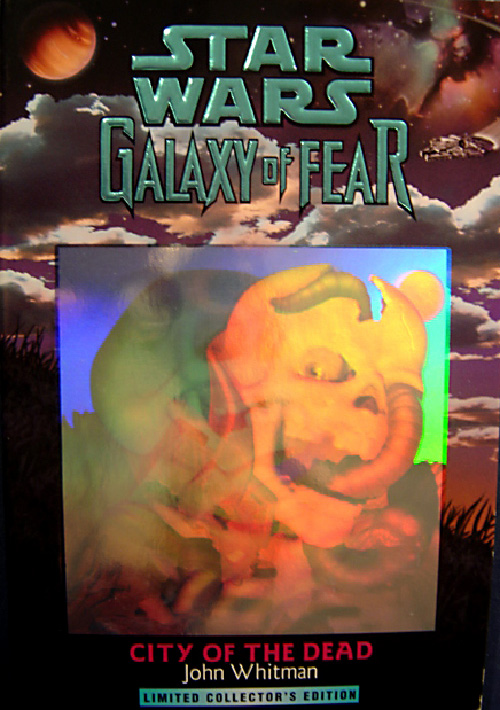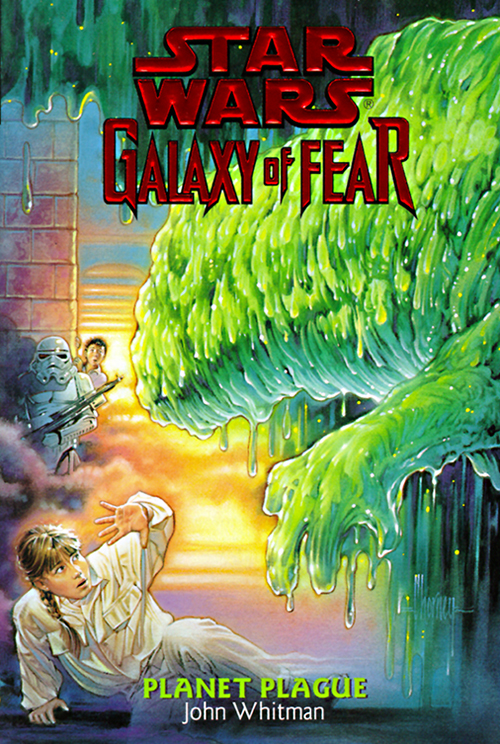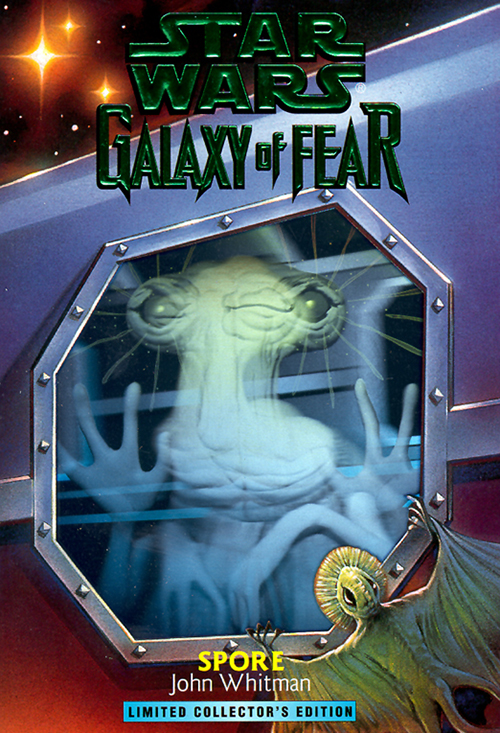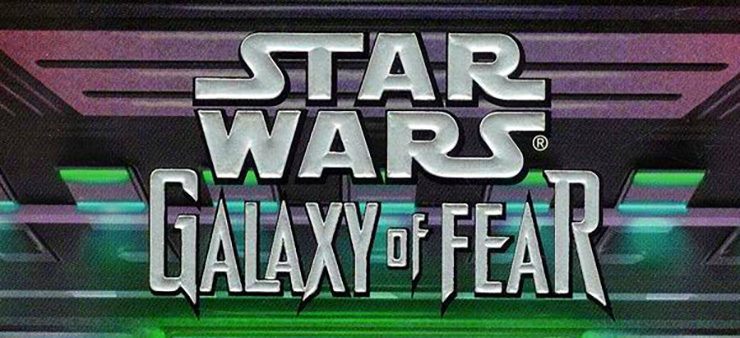John Whitman’s 12-book Galaxy of Fear series was the Star Wars Expanded Universe’s attempt to tap into the middle-grade horror market of the late ’90s—bringing Goosebumps to a galaxy far, far away. The series introduced two adorable Alderaanian orphans under the care of their mysterious shape-shifting anthropologist uncle Hoole, and set them loose into every random corner of the Star Wars universe, occasionally crossing paths all the fan favorites from the original (and at the time, only) film trilogy: Luke provides Tash some one-on-one lessons in the Force, while Boba Fett shows up to save Zak from space zombies. Thrawn’s in there somewhere, too, as badass as ever.
These character cameos made Galaxy of Fear the ultimate self-insert fiction—except if you preferred nightmares to fantasies. Because while R.L. Stine’s haunted ventriloquist dummies and egg monsters rarely provoked much of a reaction beyond, well, goosebumps, Galaxy of Fear was the stuff of your deepest, darkest fears: slimy bump monsters, boneworms that sucked you dry, brain-swapping spider robot monks, cute li’l babies that could turn people into goo and suck them up… The kind of body horror and under-the-bed monsters you would never associate with lightsabers and Death Stars and the Force.
There were harrowing moments in the movies, of course, like the exogorth trying to eat the Millennium Falcon in Empire Strikes Back, or Luke confronting himself-as-Vader in the cave on Dagobah. But those encounters were fairly tame, and were more symbolic, or at least simple; there’s something impersonal, after all, about a space slug that chomps any ol’ ship that happens to land on its asteroid. Galaxy of Fear, by contrast, turned the entire galaxy into a near-infinite haunted house, with every corner (read: planet) hung with a different horror trapping. Archetypes that shouldn’t exist, like zombies or cannibals or holographic frights that can actually harm you, were all science experiments gone wrong that could be traced back to the same singular evil.
The Empire, obviously. At least for the first six books, which were devoted to the mysterious Project Starscream. Then things got a bit more random, which is its own brand of terrifying.
Like Goosebumps, Galaxy of Fear is a litmus test for what truly scares you, for which archetype taps into some primordial terror. With twelve books, there are plenty of options to figure out your particular bugaboo. Other nostalgia pieces I’ve seen cite the eat-you-alive planet of D’vouran (wow), or the Sikadian Garden’s overpopulating carnivorous insects, but those weren’t the spooky stories that went bone-deep for me. These are:
City of the Dead

I almost passed over mentioning this one on the list, because Mira Grant’s Newsflesh series has become my zombie be-all end-all… and then I remembered the boneworms. Fucking boneworms, man—wriggling, white worms that suck all the marrow out of your hand. That they leave behind some weird slime for Dr. Evazan (yeah, that guy) to use to reanimate the dead is beside the point—the sucking is visceral enough that I still get a funny-bone-deep ache of revulsion just thinking about it.
But the scares are not just visceral: Early in the series (this is the second installment), Galaxy of Fear set the precedent for psychological horror, as well. Zak and Tash dive into this adventure on Necropolis while they’re still suffering from awful survivors’ guilt due to being off-planet during a field trip when the Empire decided to make an example out of Alderaan. Reanimated corpses would be scarring for anyone, but especially for teenagers still having nightmares about their parents accusing them of abandoning them:
A dead, gray hand rose into view.
It was followed by a pale white arm, and then strands of blackened hair. Finally the figure’s face floated into view. It was white with empty sockets for eyes, but he recognized the face anyway.
It was his mother.
As he watched in horror, the mouth moved, and Zak heard his mother’s voice moan, “Zak, why did you leave us behind?”
Thankfully, Galaxy of Fear does not devolve into a post-zombie apocalypse reality, because the undead meet their match in… Boba Fett? Yep, everyone’s favorite bounty hunter swoops in for the first of several rescues, as this cover hilariously depicts. By the end of the series, he’s a regular Gale Weathers for this franchise, saving the day while still kinda hating these kids. But like Gale, he has his moments of weakness: One trick involves stepping out of his armor to distract whoever’s chasing him, but that means that the great bounty hunter is unmasked and needs Zak to hand him his armor without looking over his shoulder, because if he spies the older man’s face, he probably won’t live to tell the tale. In a pre-Attack of the Clones world, the mere thought of finding out what Boba Fett might look like under the Mandalorian helmet was cooler than any horror-movie unmasking.
Planet Plague

The other week, I (slightly TMI) wound up with an infected cuticle that manifested as a painful boil. Staring down at my throbbing thumb while trying to work, I found myself pondering what if, instead of receding, the boil just kept growing… all the while getting slimier and bumpier and greener… until it took over my entire body?
I blame Planet Plague.
It all starts when Tash gets a strange brown bump on her arm after a routine shot on the planet of Gobindi. Instead of scabbing over and disappearing like a normal infection, however, it does the exact opposite, spreading over Tash’s skin, overtaking her form bit by bit. At the book’s climax, she is literally staggering under the weight of this tumor on her shoulders, and has to use the Force to break it apart, particle by particle, until she can get it to recede enough to regain control.
That visual still gives me shudders, but thinking back on it, what amplifies the body horror is the psychological dimension: no one believes Tash. She probably had a bad reaction to the shot, they say. That’s not how viruses work. Why is she making a big deal when there are people who are actually sick, who are—ohh. Despite very clearly demonstrating symptoms, despite possessing Force-enhanced intuition, the teenage girl almost dies because no one will take her seriously.
Army of Terror

Galaxy of Fear was scarily good about very specific, unsettling visuals. Like the swaddled infant found in an abandoned laboratory on Kiva, with a bizarre bruise on his forehead. That detail gave me an odd little shiver before I even knew about adorable little Eppon’s heritage. Like, who could have hurt a defenseless little baby like that? Or, if not, then how did he manage to bash his head, all alone? Either way, he must have been so scared and confused before Tash and Zak came across him.
Then little Eppon, who chirps his name like a goddamn cutie, starts growing. And that bruise turns out to be more of a splotch, a splotch that—remember Planet Plague?—rapidly expands into purple scaly armor covering his entire body. At the same time, Eppon is aging at a breathtaking pace, more and more resembling a monster, and feeding off whoever is in his path. And how does he feed? By turning them into jelly:
Then, with a loud, wet slurping sound, Eppon sucked the liquefied skin into himself. He simply absorbed the trooper’s face into his own body.
The rest of the stormtrooper quickly followed. Skin, bone, organs, everything, simply turned to liquid and was absorbed into Eppon.
And that’s when Zak and Tash realize that it’s not Eppon he’s saying, it’s Weapon. This adorable, abandoned baby is Project Starscream itself, a lab experiment embodying the horrifying traits from the past six books: bumpy plagues, the ability to read victims’ minds and weaponize those fears against them, that nightmarish sucking.
The worst part is, Eppon is still a sweet li’l guy who just wants to be loved. He can’t help his abominable nature, and even is able to fight back against it when Tash tries to reach him through the Force. But then his mad-scientist creator triggers the other thing he embedded within his poor doomed experiment: the self-destruct button.
These fucking books.
But after all that, it still wasn’t the Galaxy of Fear book that’s stuck with me the most. That belongs to one of the adventures from the latter half of the series, a bunch of standalones that delved even further into our lizard-brain fears.
Spore

THIS IS THE ONE THAT DID IT. The others I can laugh about, even as I find other reasons in hindsight why they were so horrifying, but for some reason I can’t shake Spore and its eponymous mind-controlling virus. Case in point, I literally tweeted about it three years ago and only remembered when googling the book for this piece:
Having so many shuddery flashbacks to the creepiest Galaxy of Fear book, Spore, w/all the mind-controlled Ithorians. https://t.co/QmOq6kIVCG
— Natalie Zutter (@nataliezutter) December 7, 2015
By this point in the series, the Arrandas should probably be suspicious when someone suggests they check out this chill mining colony in the middle of an asteroid belt filled with, oh you guessed it, exogorths. Why might a remote colony exist in the middle of space slug territory? Maaaybe because the colony is containing an ancient evil that wants so badly to “know” every organism that crosses its path that it will say whatever people need to hear. And when the lies fail, it does this:
Hodge’s eyes seemed to explode with thin, dark, vinelike tentacles. More dark vines burst from his open mouth. They lashed out violently, wrapping themselves around the doctor and sinking right into the Ithorian’s skin.
I probably shrieked when I read this passage and threw the book aside; I definitely had nightmares. And at the time, I was super into mind-control or turning-to-the-dark-side stories (Dark Empire was my jam), yet something about the tentacles bursting out of one orifice they shouldn’t be in and sinking into another—well, it got under my skin. In retrospect, the fact that it reminded me of The X-Files’ black oil, another formative horror moment, probably contributed to my very violent reaction. That, and the later visual of an infected Ithorian talking out of a mouth it wasn’t supposed to have.
All of these misadventures weren’t just nightmare fuel, they were data: Hoole winds up taking extensive notes from the dozen times they nearly died, were assimilated into a hive mind, and/or got reanimated, and compiled them into a manuscript. This he sent along to writer Ann Margaret Lewis (Star Wars Legends, you were so cheesy), who turned it into a book published on Coruscant (seriously, stahp): The Essential Guide to Alien Species. And the kids? Despite the fact that the Arrandas should have near-incapacitating PTSD by the time this series ends, they actually grow up to lead successful, relatively well-adjusted lives: both go on to study at university and become anthropologists just like their uncle (awwww), then on to the Jedi Praxeum so Tash can get some proper training (albeit probably drama-filled, it being Luke’s academy) and eventually to New Alderaan. They made it out of the haunted house!
Galaxy of Fear, you made the Star Wars universe a much scarier place, and for that I respect you.
In researching Project Starscream, Natalie Zutter got to spend a delightful afternoon down the Wookieepedia rabbit hole that took her to Trioculus, Jedi Prince Ken (Ken!), and that time Leia got her very own Buffybot. She hopes you will laugh-cry at your desk like she did. Talk Star Wars Legends books with her on Twitter!










